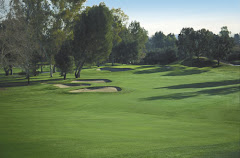 In an effort to help promote the warm season Bermuda grass, we practice deep and infrequent irrigation. Deep and infrequent irrigation means that when we do irrigation it is with sufficient quantity to wet the soil profile. Then we do not irrigate again until the water in the profile has been used by the plant or has evaporated. This deep and infrequent technique favors the deep rooted and more heat tolerant Bermuda grass. Typically for the month of July the fairways will be irrigated every third night. As you would expect the morning after an irrigation event the fairways are wet. You might get some mud on your ball and in places you may hear the water squish under the cart tires. On the second day after an irrigation things are drying out and playable is good. On the third day the fairways have dried and the course will play firm. By the afternoon of the third day you will see some drought stress on the areas of the fairways that are populated with cool season ryegrass. In the areas that are highly populated with ryegrass we will add supplemental water on the second and third day to help these areas survive until the next irrigation cycle.
In an effort to help promote the warm season Bermuda grass, we practice deep and infrequent irrigation. Deep and infrequent irrigation means that when we do irrigation it is with sufficient quantity to wet the soil profile. Then we do not irrigate again until the water in the profile has been used by the plant or has evaporated. This deep and infrequent technique favors the deep rooted and more heat tolerant Bermuda grass. Typically for the month of July the fairways will be irrigated every third night. As you would expect the morning after an irrigation event the fairways are wet. You might get some mud on your ball and in places you may hear the water squish under the cart tires. On the second day after an irrigation things are drying out and playable is good. On the third day the fairways have dried and the course will play firm. By the afternoon of the third day you will see some drought stress on the areas of the fairways that are populated with cool season ryegrass. In the areas that are highly populated with ryegrass we will add supplemental water on the second and third day to help these areas survive until the next irrigation cycle.Transition to Bermudagrass is going well this year. In addition to the other cultural practices that we do the method of deep and infrequent irrigation will ensure that transition is as quick and as painless as possible.










